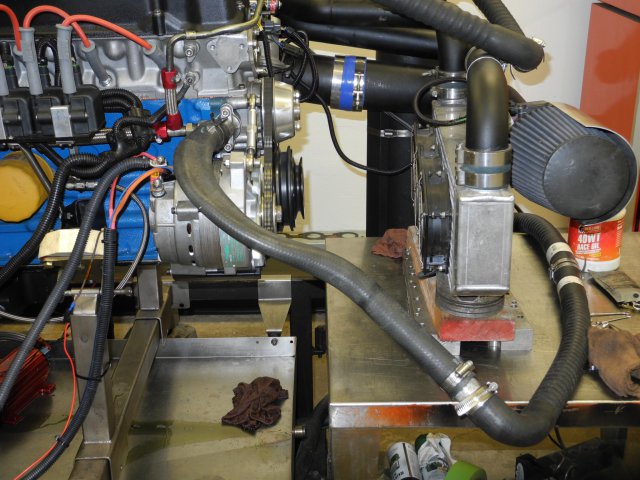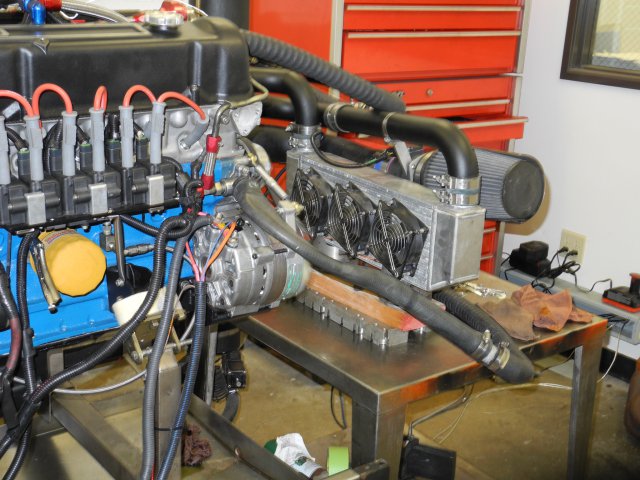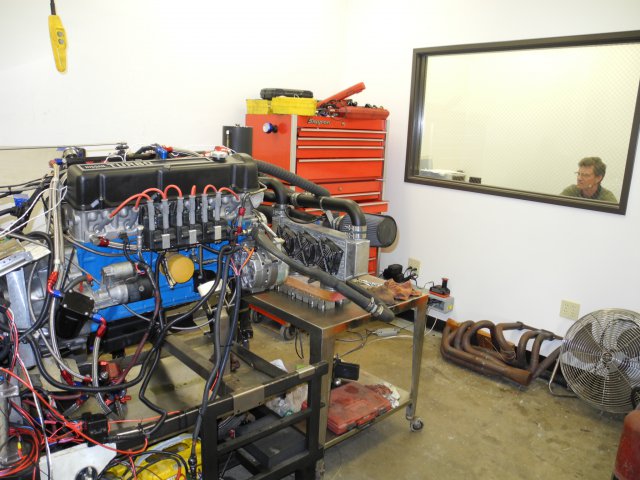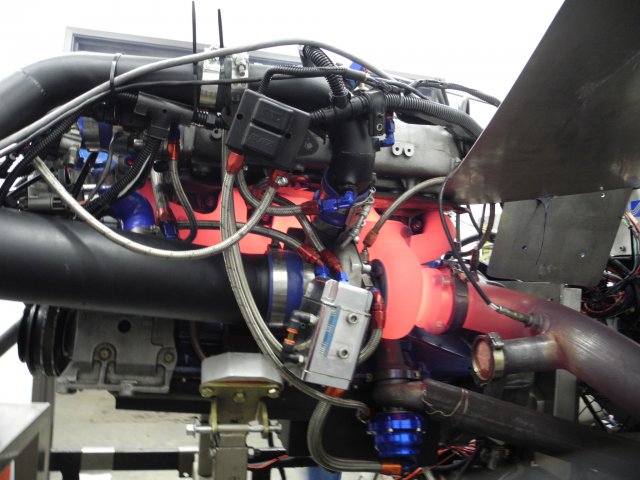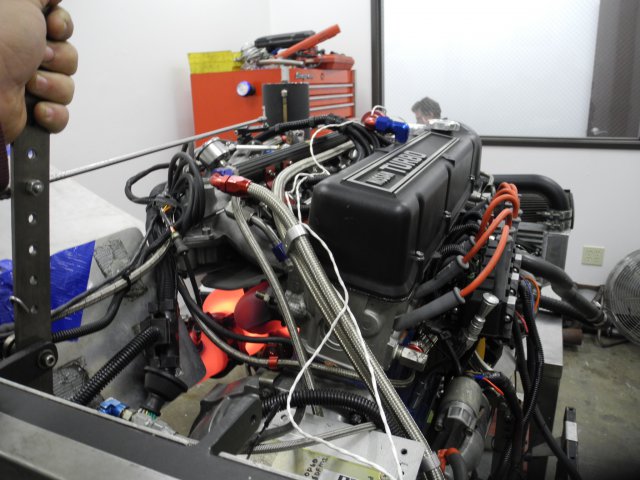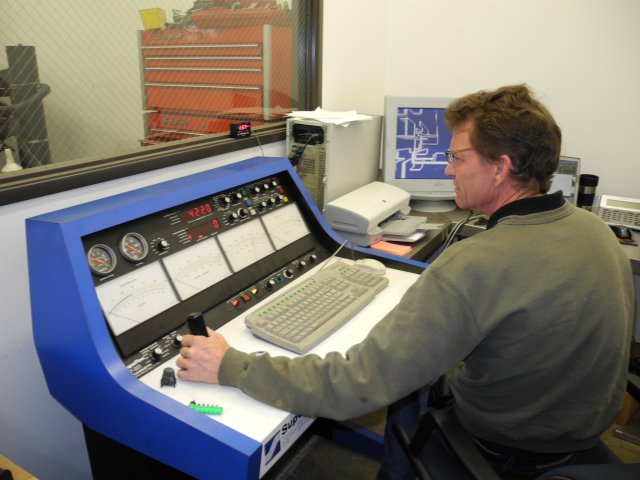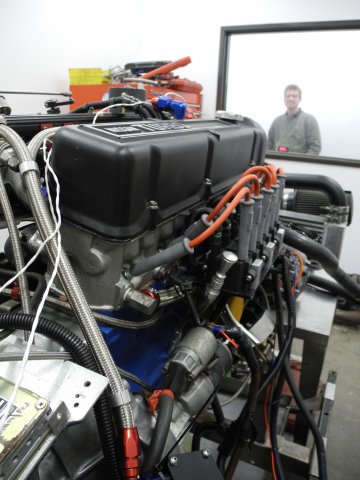-
Posts
9963 -
Joined
-
Last visited
-
Days Won
74
Content Type
Profiles
Forums
Blogs
Events
Gallery
Downloads
Store
Everything posted by Tony D
-
So many assumptions... 1) The hosese on the dyno are supplied by the DYNO. Those ribbed reinforced hoses you see? Those were brought TO THE DYNO by Jeff and I. They were confiscated by the dyno owner in lieu of some dyno time he liked them so much. There WERE 4 sections like that, but one was absconded with hence our using an outlet hose on the inlet. There is no spring in it, and that indeed is what was needed. DO NOT run a lower radiator hose without an anti-collapse spring in it!!! 2) Wastegate plumbing incomplete? LOOK AGAIN! The downpipe is turned at a 45 degree angle relative to where it would be in the car. The wastegate fits just fine to the clearly visible plugged connector on the downpipe when it's in the car. 3) Oil cooler? Oil throwoff from the mains and rods was around 100C. Sump temperatures were slightly higher. We were doing cooling systems tests holding the engine at steady state to check for some things. The cooler stayed in the car...for a reason. We learned more without it on the engine that we would have with it on the engine (similar to hooking up the head to the pump inlet and being able to block it off during testing.) BTW, do you need an oil cooler with 220F Oil Sump Temperatures and 170F CHT after running for 5 minutes at 5000rpms steady with XXpsi boost and making a load over 390ft-lbs of torque? 4) It looks like a stock block, doesn't it? Try gettting the conditions in #3 above to happen in a bone-stock F54 Block, or N42 for that matter!
-
Oh, and another observation: Use a lower radiator hose with a spring in it! Like clockwork, this happened above 4500-5000 rpms! Jeff was busy, and didn't see my 'DUDE THE HOSE IS FLAT!' gesticulations...
-
At long last more to report. The 'loop the hose when the heater is bypassed' was finally tested today. Long and short of the testing was that with the back of the head looped straight to the pump inlet (like some do when bypassing the heater core---instead of blocking it off)the following results were obtained using the Nissan CHT as read through the Nissan ECU. With a 25hp load on the engine running 4500rpms and the hose looped and open, CHT=220F With a 25hp load on the engine running 4500rpms and the hose BLOCKED CLOSED, CHT=170F Results obtained on a Superflow 900 series Dyno, with the thermostatic water valve set to maintain 160F water. The tests were stopped at 4500rpms as the suction hose on the dyno would start collapsing above that point. This would be similar to stock gearing at 80+ mph or thereabouts. What we wanted to see was how high we could go before the 'open hose' started to rise in temperature, but even with a collapsed hose above 5000rpms we could not get CHT above 170, whereas with the hose open and flowing to the pump inlet (which you think would help prevent the hose collapsing...) the temperature started to rise even more above 4500, so we figured stopping the test there was the best comparison. Results at 3000rpms were almost identical when the engine was 'stabilized' --- that is run in steady-state load for several minutes. Yes, we were running the engine for several minutes at a time checking load points, etc. Let temperatures stabilize then run to a higher number. So nice not to have to stop and let everything cool down! Mmmmmm, engine dyno! Gaaarrrrggggh! Later the engine was put through...uh..."More Rigorous Testing" Wallpaper, Anyone? Look, you can see Jeff almost looking happy! And the 'clamping device' to stop the flow in the hose. So much for the commentary earlier in the thread, huh?
-
I haven't checked these out guys, it's been in the back of my head ever since I realized the Z's standard first overbore is the same as the 1641 I have in my old bus. They come in about 1000 different pin heights as well, to accomodate strokes from the stock 69mm, to over 84mm---meaning to me there should be some combination that should work well with some long-rod long stroke combination. Due to the aircooled temperatures, they should be high-silicon for lower expansion in the jugs. I've got over 65K miles on my engine without a hiccup, and I have overheated it for one reason or another several times. They are flat tops, and pretty thick domes. It's not uncommon for guys to shim the bottom of the barrels for deck height, or simply cut the piston tops to make deck height on some setups. The VW has 87, 88, 90.5, 92, 94mm Jugs and Pistons as pretty standard. They have some smaller ones as well in the stock sizes, but they don't always come in the variety of stroker pin heights, etc... I mean the VW guys use Chevy 5.700" rods! So you want to talk 'cheap performance'? Go check the prices for some really good lightweight 5.700" Chevy Rods...and remember for that $237 you get enough to do TWO complete VW's! Most of the specs for pin height and that are out there, and the longer stroke kits will have very short skirts with cutouts to clear the counterweights (hell we got to machine the cam to clear the crank counterwieghts on the big stuff!) so they won't look so "industrial"... Someone wants to look into it further, have at it. I'm busy as hell now, this was just the opportunity to brain fart it out there---you can see the pricing... Might be worth it if pin offset is right, I mean hell---Vega Pistons and XL500 Honda Pistons work, why not VW's? It would be nice to know for sure, because that 69mm crank is the same stroke as the L20A, and putting that in various larger bore engines might work out for a displacement class break proposed at El Mirage... Parts is Parts!
-
87 mm is a very common VW overbore... I don't know if anybody used them yet, but sets of VW pistons are cheap in comparison to others. So what if you chuck the jugs away? I think you could buy two sets of 87's and have two spares (with rings!) for far less than $800! CAST FORGED MAHLE Pin Diameter is 22 mm, full floater with retainers.
-
Some sick individual once made an EGR manifold out of Swagelock connectors and T316 Stainless as well...Lesson Learned: Use bigger tubing than you think if you're pumping EGR! (Also that 'brown' stainless steel tubing is damn hot to the touch!) There is no end to what deviant things we can make if we set our minds to it. With the advent of cheap EFI and those tasty EGR Coolers on all the big diesels it may be time for a revisit of this debauchery!
-
They are bolted onto the car they don't fall off, they are very durable and are retained by the bumper when you remove it. I left that out in my original response, apparently that makes me some sort of filthy-foul bag or whatnot in the eyese of those who didn't answer the question... I love it when people take offense to something they had no useful contribution towards rectifying. Such useful discourse. I'm glad someone finds it amusing. For the most part, it's a waste of a post and space, but then again that's just my opinion. If this is 'basic fitment 101' I'd say ask it over at Classic Z Cars and you will get all sorts of answers which will make you all amazed. But again, it's not in the parts book, and preproduction models don't count. At least not the way I read it originally, as stated in my filth-foul bag (apparent) response. I think some people want to be offended, you know? Like they look for it. I wish I had that much time on my hands...
-
Use a single coil with an 81 ZX Dissy, or single coil with a 82/83 ZXT dissy/CAS unit. Firing the coil in-phase with the rotor and tower you want is pretty straightforward. The MS-1 will do that! If it's not boosted, you won't have any issues up well past 8000 with a single coil if you get the bosch turbo unit that nissan and everybody used. Very fast saturation time. It will look like a functioning distributor, because it IS a functioning distributor. But all it will do is point the spark where it needs to go. Stick a little vent to the intake box on the filtered side so you get air transfer through the cap, and ionization will not be an issue.
-
If you add a turbo drain hole to it, it will work. That is the pan (suitably modified) that JeffP put into his L28ET in his 280ZX. It ain't 8 quarts no more in a ZX...
-
" It gets strong smelling on decel with the window rolled down that creates a vacuum affect on the rear hatch seal. The low pressure in the car invites that exhaust in and passes by me on its way out the drivers side window." Another piece of "Emissions Related Crap" prevents or significantly reduces that (two things...uh, THREE things actually... 1) Idle Snubber Dashpot. This keeps the throttle plates closing the last several degrees VERRRRY slowly. This provides residual O2 into the combustion chamber to give a little combustion. 2) The Throttle Vacuum Pull-Off. This is the thing that when you snap the throttles closed over 3000 rpms makes the throttle close slowly over 3 seconds over the last say 1/4 throttle movement range. MAIN contributor to O2 in the exhaust so you don't get the massive spike in drop-throttle HC's due to shutting off all the O2 available for combustion. 3) AIR Pump / System. This simply pumps the O2 straight into the exhaust to post-combust the HC's in the head and exaust manifold. With an AIR pump attached to my 71 with headers and SU's I piped clean to catalyzed 83 standards. ALL the above 'Emissions Crap Devices' will extract MAYBE a total of 2HP from the engine. If you don't use the AIR Pump, there is NO PENALTY WHATSOEVER but a DRASTIC reduction in HC emissions. The Toyota 2TG and 18RG engines used both the throttle pull off and snubber dahspot for HC reduction. For their AIR system they used a 'Gulp Valve' arrangement which did not extract ANY horsepower, and would be easily adaptable to these cars with triples. In fact, my 1977 Toyota Celica GT with an 18RG-R running dual mikuini PHH's ALSO had a CATALYST on it, and we emissions calibrated to a tailpipe standard STRICTER than CALIFORNIA CELICAS with the SOHC 22R (or 20R, I forget which...damnable industrial refrigeration engine...) There is absolutely no reason 'performance' needs to mean 'polluter', unfortunately very few people take the time to intellectually analyze their actions and simply cut, strip, and discard from rote that which they don't understand or take the time to understand. Years of 'experts' telling them 'emissions crap steals performance' and getting hung on a 2 or 5HP loss compared to a non-compliant car just steers them down a path which ends up being bad for everyone involved. Yeah, retaining some of this stuff will be work... But if your eyes don't water when you drop-throttle decel... If you don't have ANY HP penalty (using a gulp valve instead of the AIR pump)... Is it worth it? And to be sure, converting those Triple Carbs to EFI with some screw in injector bungs and gutting them for use as nostalgic throttle bodies would solve that drop throttle eye watering issue as well. Every ECU has a decel-injector fuel cut subroutine, and when you have NO fuel in there you can't pump HC's out to make your eyes water! It's one of the biggest things you notice when you go to EFI from Carbs. The places where you got misty-eyed suddenly aren't so fume-acious as before! I digress...
-
Talk with Frank280ZX, he's swapped many Z31 components onto his S130. Though I don't know why you would need the K-Member for a swap. A VG Fits with the stock K-Member in there.
-
Have you used a scope to probe the signal to the ECU from the CAS? Or are you getting a pulsed signal to the ECU from the CAS as you crank (DVOM set 0-5VDC and probing appropriate pins in the cable?) Are you (with the DVOM range set 0-5VDC) seeing a 'pulsed' signal on the 'yellow wire' from the ECU to the Ignitor? Can you force a spark simulating a pulse into the ignitor? Time to break out the FSM to trace some wires and see where probes need to be. Until you figure out where you have a pulse, and where you don't, you're just guessing. The circuit is very simple, CAS-ECU-IGNITOR start at one end and go till you loose your signal. The last component to get a good signal but not send it out is bad.
-
?
-
What's a flywheel anyway? It's not like it does anything, it just spins around. Just shave it, you will be just fine that SFI crap is just to make money for aftermarket manufacturers...
-
Preproduction cars as magazine testers don't count. I thought the question was from a factory installation standpoint for a normal production run vehicle and not a trick question of 'were these ever on a car ever shipped to the usa for testing and evaluation including those cars classed as proproduction prototypes'... The production cars don't have them, and there isn't a part number in the 240Z US Fiche for them accordingly. It is, on the other hand, in the Fairlady Z parts book...
-
Yeah, the 432 Box was nothing more than a box, with a duct to a cannister filter mounted near the radiator core support. The more volume it has, the more fumes work to pressurize it to the point of backflowing through the filter media! We are talking inches of water column here!
-
Incorrect, the CAS units are interchangable, they give the same signals to the ECU. They are plug-and-play interchangable. I know, I've gone both ways on this at any given time. Currently I have an 83 CAS in an 81 right now. Previously I'd retrofitted an 81 engine with CAS into an 83ZXT 2+2 and did nothing more than plug the harness in...they are the same to the ECU. How they are derived is slightly different, but the signals and waveforms on the two distinct signal channels as read by the ECU are identical!
-
Please keep in mind a catalyst doesn't do anything most of the time, it's for scrubbing the exhaust during transients! This is a common misconception. A catalyzed car runs clean through precision fueling, not by virtue of a post-combustion scrubber! When you accelerate quickly you pump extra HC's out from lean and rich transitions...when you misfire a plug...when you have a sensor failure---THAT is when your Catalyst is working and working hard. Places like WOT and partial throttle cruise---it's doing nothing for HC Reduction. I ran my 73 through a California Smog Check when I originally came to the state, and it tested clean to 83 catalyzed standards using an AIR pump and not much more than properly tuned timing and SU's. Amazingly clean. The EFI will allow a wider range of 'correct' mixture, but don't think a catalyst will help if you don't have that proper mixture control. The BIGGEST thing you will notice will be decel fuel cut. THAT ALONE will noticably increase your fuel economy and almost totally eliminate the 'eye watering experience' inside the Z... Keep us posted on the updates. Myself, I just found the DIY PNP Setup for the Megasquirt for my Rat-Motored Tow Rig and was considering it, knowing full well the old ECU's were fully back-hacked. I now have to thank or curse strotter for giving me quick access to the information I need to do it without changing my ECU. I have always liked the GM ECUS, and having been trained in them at their inception I'm comfortable with their subroutines and durability. Hacking makes me more comfortable than total replacement. It's worked flawlessly for 20+ years, why change it when I can just tweak it! (And the fact that the original Turbo City VW stuff was all GM ECU based EFI as well, and I worked on that now for 20+ years as well... damn I'm getting old...)
-
I have to agree with Ray 1000% on this, after doing my hoses and fuel system on my turbo car, I could maintain not a couple inches of water in the system, but a couple of PSIG! Absolutely no leakage. I would say the 0.020" leak he is registering is the diverter valve allowing crankcase accumulation to leak past the crankshaft seals---which on a PROPERLY MAINTAINED SYSTEM should be the ONLY leak path for the vapors! Retrofit a double or triple lip seal in their place and even that can be improved. My PSIG check was with the diverter valve plugged to test total fuel system integrity, doing it like this if I dent my gas tank, I can (and have!) literally blown the tank back straight with up to 5-10psig in the filler hole! The system IS tight. The only place for it to 'leak out' is the front and rear seals. One of the startling differences was when I went from 44PHH's to TURBOCHARGED Blow-Through PHH's... No more gasoline smell after shutdown. Captive emissions in the surge tank. The 240Z uses crankcase accumulation of gas vapors, and without a closed element air cleaner, proper heat shielding, and a functioning PCV system (what good does crankcase accumulation of vapors do if you just let them vent out through the valve cover 'filter'?) If you can dig up some of Carl Beck's photos of the original 165HP L24 with triple 40 PHH's you will see an air cleaner very similar to the Z432. Also very similar to the Toyota 2T-G or 18R-G. None of these cars gave off objectionable vapors in OEM configuraiton. As a matter of fact, I had several GT Toyotas with the DOHC Engines and Mikuini Carbs (latest model was a 1980 Carina GT) which had no more 'gasoline vapors' than a comparable 280ZX which had EFI. The next year they went to EFI on the GT engines and the carbs were gone...but there was no noticable emissions increase in the garage that I could tell. These systems are not that difficult to understand, it just takes some time to learn about them and then understand what they were doing. Likely nobody will want to make an OEM looking filter box, but that really helps. As does a heat shield. Toyota carbs (Mikuini PHH's) actually had some vapor dashpots to allow the vapors to go to a carbon cannister after 1974, same as the 260Z. There's no reason triple have to be gassy and smelly. But if you are running an open element air cleaner and put it away hot...you WILL have vapors ad nauseaum! (Literally!)
-

Early 1970 240Z at Ecology! SAVE IT!
Tony D replied to DezertZ9's topic in S30 Series - 240z, 260z, 280z
" seems like a government protection racket for the domestic market. " Like any other country. This also exposes your unfamiliarity with importation channels. A personal importation is EXEMPT from Federal Emissions Requirements if the vehicle is 5 model years old or older. You still have DOT to contend with, though. At least it once was... If the vehicle is old enough, there is NO compliance required... You're sorely misinformed on why we have 91 here in CA... sorely misinformed. You need to get more information before making comments such as these. You're way off base. I'm being polite. -
They are an example of 'decontenting' of the 240Z for hte US Market. They are a Fairlady JDM piece, they were never installed on the 240's. It's a nice finisher piece though.
-
What functional EVAPORATION MITIGATION SYSTEM do you have in place? This is usually the 'emissions crap' most people take off when doing this kind of conversion---what did you do to preserve the integrity of yours? Do you have a closed-element air cleaner and properly functioning EVAP system on the car after the conversion? If not, start there. They did have a proper EVAP system on triples from Nissan in the OEM Triple Application (the 165HP L24 never imported or marketed, and the Z432)... But don't kid yourself, it's not a modern car with total captive emissions containment. There will be some odor. If it's up since you changed from SU's go back, look what you 'eliminated that you didn't think you needed and start retrofitting it to get back to equivalent SU emissions in the garage!
-

Early 1970 240Z at Ecology! SAVE IT!
Tony D replied to DezertZ9's topic in S30 Series - 240z, 260z, 280z
It IS that they were arrogant. I see the attitude all too often. They thought they could pull a fast one and are now shocked that the LAW is actually being enforced. Like I said on another topic, most people are shocked when they are caught in the act of being guilty. There was more to it that 'a proprietary washer' --- the facts of the matter were they were outright fraudulent in their federalization. Upon further in-depth investigation it was found that it was IMPOSSIBLE to maked them comply. But as said before: the law is the law and don't get shocked when you break it and get caught! Properly importing a vehicle is NOT that hard a task, but vechiles aren't as simple as they once were. The root of this whole debacle with the Skylines was they thought they could bank on the 'when was the last time' mentality---there were a lot of knowing and unknowing people caught up in it, and they all got burned---some deservedly so. As someone who has LEGALLY imported non-conforming vehicles to the USA in the past, I find it laughable that someone gets burned for pulling a fast one and then is shocked. For me it's a nice 'well, someone was awake at NHTSA today...' PERSONAL imports are EXCEEDINGLY EASY to accomplish. You do it as a BUSINESS, you best mind your P's & Q's because it's a BUSINESS and you WILL be held to the same standard as any other OEM importing vehicles. As for bill of lading, duties, etc... you CAN have it. But you bought it and imported it under the RULES---it you didn't read and understand them when you did it...uh...don't cry to me that you have your vehicle confiscated because you are in violation of the agreement you made when you imported it---they tell you it must be reexported after a year or destroyed. You think you should be exempt from that contractual obligation? I detest rules as much as the next guy, but I at least don't cry when I get caught trying to pull a fast one. Whining on an internet forum isn't going to change it. Watch who you elect, move to change what you don't like. But in the meantime, don't express shock when the law is enforced! Sure there are plenty of others to enforce that would seem to me to be a better way to spend the money...but then again to see anything enforced is better than nothing. Vote Right. -
download the FSM for an 83 turbo and check the CAS (dissy) installation and timing instructions. The signals put out by the 81 CAS and the 82/83CAS are identical. Either ECU will work with either CAS as long as it's phased properly.

